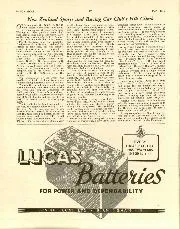
New Zealand Sports and Racing Car Club's Hill Climb
New Zealand Sports and Racing Car Club's Hill Climb ON January 4th the N.Z.S. & R.C.C. held another successful hill climb at their course at Judgeford, near Wellington. The previous…
Back in the mid-1960s I was with Motor Racing magazine and a newly-launched stablemate named Miniature Auto. Alongside my motor racing fixation I was an avid model maker, and at that time slot-car racing centres were just gaining a British foothold. One day my colleague Darryl Reach – editor of the new Miniature Auto – and I drove to Clacton (yes, we got all the very best gigs) to view a brand-new slot-car centre there. I’ll never forget our arrival, the proprietor greeting us warmly and bawling over his shoulder “Maurie – put the kettle on! Very important visitors!”.
Then he showed us the biggest multi-lane slot-racing car track I’d ever seen, and we were eager to have a go. But what disappointed me, as a fine-scale purist, was the lack of trackside scenery. Reared on model railways I missed the trees and buildings – and then there was the total unreality of the scale speed the slot cars achieved.
When I worked out lap time against lap length, the 1:24 scale speed proved to be – from memory – something like 400mph. It was preposterous. Any slot-racing interest I had pretty much evaporated on the spot. I’d rather indulge in real-time speed, track testing, record runs and rally rides… I expect you’ll know the feeling.
Now this memory from the mid-1960s came back to me in spades at this year’s Goodwood Festival of Speed. I have vivid memories of Nick Heidfeld’s utterly blistering 41.6sec record-setting climb there in the works McLaren-Mercedes MP4/13 in 1999. The specially-prepared Formula 1 car’s bump reactions and his tiny steering corrections had the McLaren flickering edgily side-to-side, so just watching the climb was heart-in-mouth stuff. The visual impression as that screaming 17,000rpm Ilmor-Mercedes V10 engine rocketed the McLaren past my vantage point near the paddock bridge remains indelible.
But this is where the unreality of watching a slot-car lap comes in, because when this year’s entirely extraordinary McMurtry Spéirling electric twin-fan car sped its way up the self-same hill in a shattering new record time of just 39.08sec, 106.858mph, its progress was so unbelievably fleeting there was hardly time at all to register its passing. “Like a slot car” shot to mind.
“Gordon Murray’s ‘fan car’ hoovered Niki Lauda to victory in the Swedish GP”
Quite how driver Max Chilton was even able to think and act quickly enough to keep ahead (just) of the projectile itself shook this always sceptical observer to the core. And watching the video of that climb looks just as unreal as the view of serious state-of-the-art slot cars at Clacton Pier all those years ago. But instead of blinking, shaking my head and thinking “Hmm – that’s not for me” the sight of Chilton in the McMurtry ‘Thunderstorm’ – as ‘Spéirling’ translates from its Irish root – left me with nothing but admiration for both this attractively discreet little futuristic manufacturer and naturally for its ex-F1, ex-Indycar driver.
Of course the McMurtry takes a leaf out of Jim Hall’s innovative – and subsequently banned – Chaparral 2J ‘sucker car’ of 1970 Can-Am Championship fame.
Its twin tail-transom fans were spun-up by a 247cc twin-cylinder two-stroke Rockwell JLO engine, whose 45hp normally powered snowmobiles. Sucking air out of a skirted area beneath the 2J’s box-like planform, the fans generated immense downforce, glueing the car’s tyres to the road surface.
Brabham F1 designer Gordon Murray famously revisited the notion in reaction to the Lotus 79 ground-effects car of 1978, his since-renowned Brabham-Alfa BT46B ‘fan car’ – using a system part-detailed by too often overlooked assistant David North – hoovering Niki Lauda to victory in that year’s Swedish GP at Anderstorp.
But just like the Chaparral 2J, the Brabham fan car’s ingenuity showed us a short-term future to which rivals took instant – and intense – exception. Team owner Bernie Ecclestone for once avoided confrontation by agreeing to retire the option, much to Gordon’s disgust, but the cars’ progress round Anderstorp – trailing a banner cloud of fan-efflux dust and grit – presaged real danger for following drivers on other GP courses which might have been far less Scandinavian clean.
The McMurtry’s charge up the 1.1-mile Goodwood hill certainly demonstrated that trailing banner-cloud syndrome, fan-ejected dust and grit being blown by a mixture of the wind and slipstream vortex over the flanking straw bales and into many spectator’s jaw-dropped open mouths. I cannot remember ever before hearing such thunderstruck gasps from motor racing spectators, except perhaps from Silverstone when the Indycars raced there, also in 1978 – since at that time, along the straights, they were so visibly quicker than the Formula 1s to which we were accustomed.
For me that Silverstone Indycar meeting was memorable for another reason – one of the most stupid questions I’ve ever asked a racing driver (tough competition). I asked Johnny Rutherford “So Johnny, how do you find the circuit here?” – to which he replied: “Well ah just drive down the pitlane and – why – there it is!”.
I’m not sure which startled me most. Nick Heidfeld’s record breaking Goodwood climb in ’99, Max Chilton’s latest record-shattering climb in the stupendous McMurtry, or Indycar Champion Rutherford’s lovely line back in ’78. It’s appreciating variety that keeps us going…
Doug Nye is the UK’s leading motor racing historian and has been writing authoritatively about the sport since the 1960s